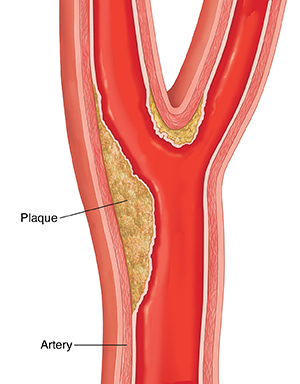A
B
C
D
E
F
G
H
I
J
K
L
M
N
O
P
Q
R
S
T
U
V
W
X
Y
Z
Click a letter to see a list of medical procedures beginning with that letter.
Click 'Back to Intro' to return to the beginning of this section.
Carotid Artery Problems: Surgery for TIA
The carotid artery is a blood vessel in your neck. A transient ischemic attack (TIA) is when narrowing in this artery blocks blood to your brain for a short time. It's caused by a substance called plaque that has built up in your artery. A TIA doesn't cause permanent damage to the brain. Symptoms go away within 24 hours. But a TIA is a warning sign that you may have a stroke in the near future. You and your healthcare provider will discuss the best treatment plan for you.

Your treatment plan
Surgery is one way to treat a TIA. The need for surgery depends on your symptoms. It also depends on how narrow your carotid artery is. If you have mild narrowing but have had more than one TIA, you may need surgery. If you have severe narrowing and no TIA, you may still need surgery. This is because your risk for stroke may be high.
The surgery is called a carotid endarterectomy. This removes plaque from inside of your carotid artery. The inside of your carotid artery is made wider and smoother. This helps your blood flow normally to your brain. It reduces the chance of having a stroke.
Call 911
Call 911 right away if you have any of these stroke symptoms:
-
Weakness, tingling, or loss of feeling on 1 side of your face or body
-
Sudden double vision or trouble seeing in 1 or both eyes
-
Sudden trouble talking or slurred speech
-
Trouble understanding others
-
Sudden, severe headache
-
Dizziness, loss of balance, or a sense of falling
-
Blackouts or seizures
B.E. F.A.S.T.
B.E. F.A.S.T. is an easy way to remember the signs of stroke. When you see these signs, you know that you need to call 911 fast.
B.E. F.A.S.T. stands for:
-
Bis forbalance. Sudden loss of balance or coordination.
-
Eis for eyes. Vision changes in one or both eyes.
-
F is for face drooping. One side of the face is drooping or numb. When the person smiles, the smile is uneven.
-
A is for arm weakness. One arm is weak or numb. When the person lifts both arms at the same time, one arm may drift downward.
-
Sis forspeech difficulty. You may notice slurred speech or trouble speaking. The person can't repeat a simple sentence correctly when asked.
-
Tis fortime to call 911. If someone shows any of these symptoms, even if they go away, call 911 right away. Make note of the time the symptoms first appeared.
Online Medical Reviewer:
L Renee Watson MSN RN
Online Medical Reviewer:
Rita Sather RN
Online Medical Reviewer:
Steven Kang MD
Date Last Reviewed:
4/1/2024
© 2000-2025 The StayWell Company, LLC. All rights reserved. This information is not intended as a substitute for professional medical care. Always follow your healthcare professional's instructions.